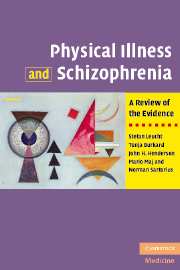1 - Introduction
Published online by Cambridge University Press: 08 August 2009
Summary
Schizophrenia is a chronic disease that afflicts approximately 1% of the population worldwide (Freedman 2003). It usually afflicts people at a young age and, according to a report of the World Health Organization, it is among the seven most disabling diseases in the age group between 20 and 45, far surpassing diabetes, HIV or cardiovascular diseases (World Health Organization 2001). A number of reviews have shown that there is an excess mortality in people with schizophrenia, the overall mortality being twice as high as that in the general population (Allebeck 1989, Brown 1997, Colton and Manderscheid 2006, Harris and Barraclough 1998), so that schizophrenia has been called a ‘life-shortening disease’(Allebeck 1989). Suicide and accidents account for about 40% of this excess mortality (Baxter and Appleby 1999, Black et al. 1985, Palmer et al. 2005, Tsuang et al. 1999); the rest is due to physical illness. Despite this excess mortality due to physical diseases, the concern for the somatic well-being of people with schizophrenia has been neglected for decades. A number of reasons account for this neglect, one of them being the stigma related to psychiatric disorders (Sartorius and Schulze 2005). A recent population-wide study in Australia (Lawrence et al. 2003) showed that although people with schizophrenia suffer more frequently from cardiovascular problems than the general population, they receive revascularization procedures less frequently than the general population.
- Type
- Chapter
- Information
- Physical Illness and SchizophreniaA Review of the Evidence, pp. 1 - 2Publisher: Cambridge University PressPrint publication year: 2007



